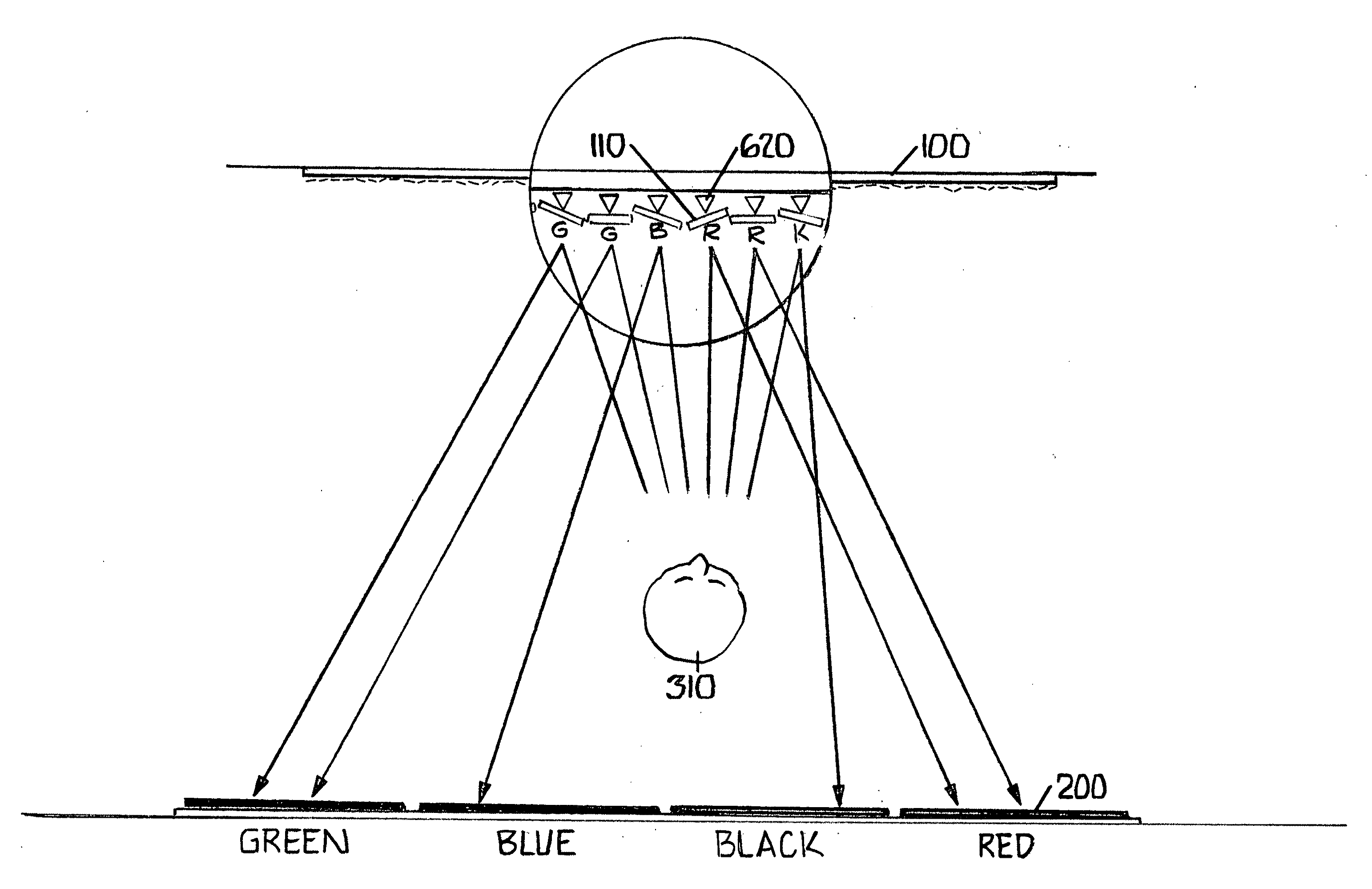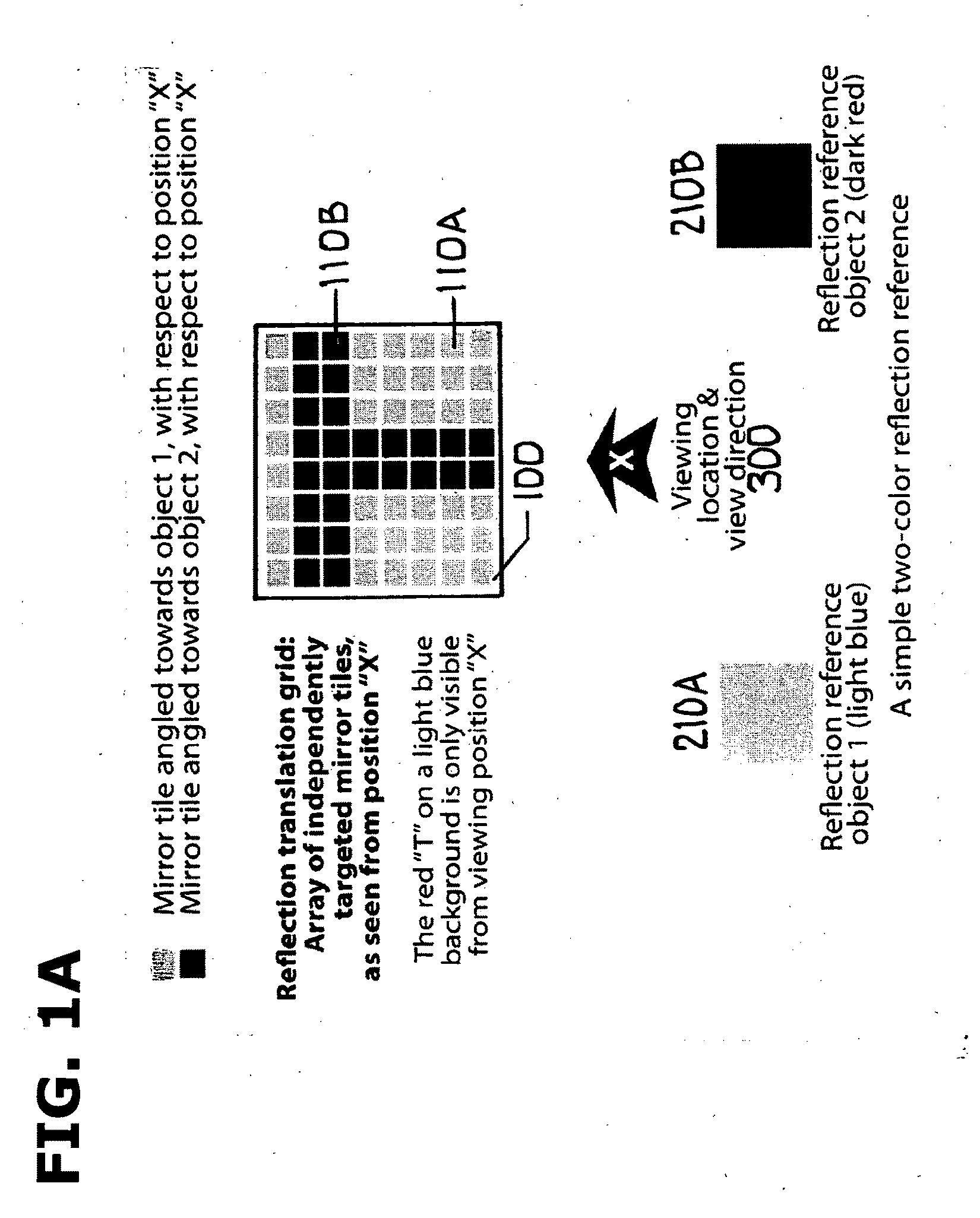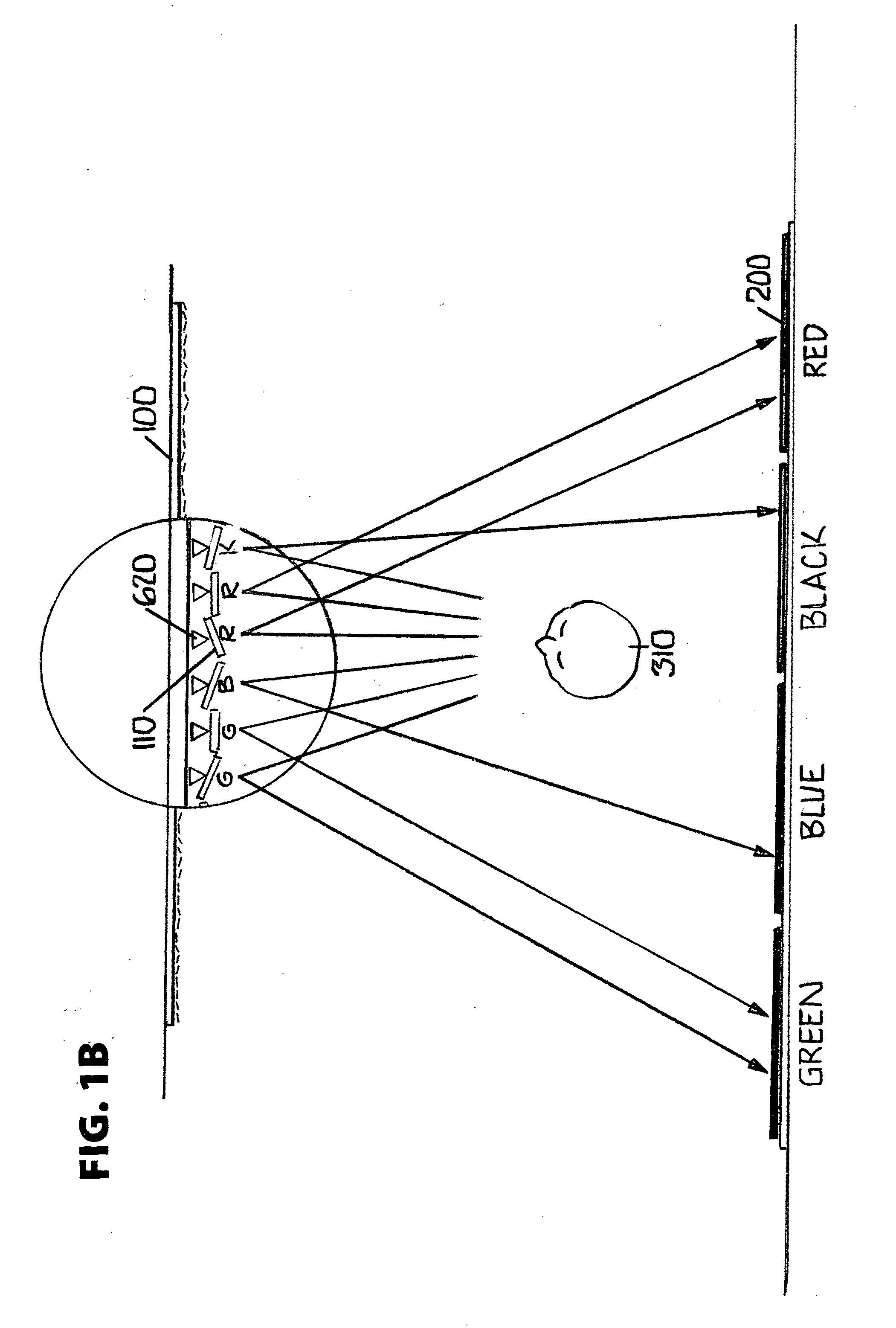[0016]The colors in an angled mirror mosaic display are abstracted away from the viewing apparatus in a way roughly similar to how a computer display's color palette is abstracted away from the onscreen image, stored in memory where it can be freely and programmatically manipulated, or references to it can be manipulated, in both cases to invoke effects on the displayed image. Both displays' colors are not determined by manipulating actual spots of
pigment on a display but, much more fluidly, by manipulating numbers, which then determine the display colors. In the mirror display, the number from which color is derived is the array of mirror tile angle settings. These angles use
light reflection vectors roughly similarly to how a
computer image uses a digital color
lookup table. In both cases, the abstraction between color and display allows programmatic manipulation of the contents of the display. The abstraction of color, away from the mirror display allows, in one sense, a layer of
software in a physical object, where image effect algorithms can be implemented by the group manipulation of mirror angle settings, and these algorithms can be executed by the real-time interplay of light when the viewer moves along a preset viewing path to invoke a predetermined collective reflection vector movement, thus invoking a predetermined sequence of changes in the reflective source colors of each tile, resulting in an animation or image other effect.
[0018]In a more versatile version of this type of display each mirror / pixel is actuated live by computer, and able to be quickly and precisely retargeted—re-angled—to new color sources, several if not 30 times per second, taking a fraction of that time in transit between angle settings, thus supporting high-speed “reflection re-set animation”. This live actuated embodiment is much more versatile than static mirror array reflected-color reference animation, which is based on mirror pixels reflection-tracking over printed pixel animation histories, and is therefore limited to preset printed content. In addition, a further-enhanced live-actuated embodiment tracks, through a real-time video feed, both viewer position and all color reflection source positions and their changing color characteristics. By tracking viewer position, especially
eye position, and adjusting all tiles to compensate for changes in viewer position, the actuated reflective display can under
computer control ensure that the reflected images and effects remain in view as the viewer moves at will. By tracking the color environment, real-
time changes in available reflectable colors can be incorporated into the scene, enhancing a wealth of
software controlled interactive and other visual effects. For one example, if a red car enters the scene it can be tracked and reflected and constitute the source color of a bouncing ball for part of its drive-by, and then the reflection of the car can be morphed into a realistic reflection of a red car.
[0024]The reflectable color set can thus be a pre-existing random
constellation of colors, or be an augmented random set of colors, or can be an entirely constructed image—a very precisely designed color pattern, sometimes reverse calculated from desired display effects. Display effects can be very complicated, and the reflective reference color maps required to produce them can therefore be very complex, large and elaborate.
[0032]Reflectable texture is a
specialty application of the more general and purer idea of identifying and using
solid color sources used in mirror arrays to allow mirror arrays to in many cases most directly emulate certain basic traditional display type characteristics. Most of the effects described herein pertain to the interplay of
solid colors, and in most instances the color-reflective mirror array effects discussed are dealing with
solid colors. Many of the effects discussed use gradients as color sources, but treat the sections of gradient as solid colors, since perceptively, they are in effect solid colors. The same principle applies in many cases when compiling ambient environmental reflectable color lists, where a nearby green tree has both texture and shade changeability, affording an opportunity for these have to be registered as palette attributes, for proper or accurate image composition. Such a tree color source is not a solid green. A distant tree, by contrast, is, effectively, a solid green, and will be useful therefore in different and generally more versatile ways. The potential combination of pure color effects and the wide range of texture, movement, time-dependent reflectable color sources and a myriad of other reflectable environmental visual characteristics provides an additional wide range of creative and utilitarian advantages to reflection based imaging as described herein.
[0034]There can be different color source swatch sizes for different parts of a given image, and therefore different viewing area sizes for those different parts of the image. For example, most of an image of a house can be constructed of wide viewing angle colors, while at the same time the window panes of the house's windows are constructed of narrow viewing angle colors. This allows a viewer of the image to move within a
wide area and see the image of the house and windows, though the windows will be blank, and then move into a small section of the wider viewing area from which to see colors and images in each window. Each separate window's content can, also, become visible from a different area within the wider viewing area. Or a combination of still image and animation can be used to present short animations within small sections of a larger still image, in this case perhaps displayed in a window pane or as a
television screen seen faintly in the house through a window.
[0035]If all colors in a given image are referenced from very small swatches, then the entire image's viewing area will be very small. Narrow viewing angles for individual images or effects facilitate the presentation of multiple separate viewing areas, of entirely different images, and many other interesting effects, such as animation and 3D imagery. As noted, to present 3D images, each eye is simply presented with a different color, at each mirror / pixel, to thereby construct two separate images, one for each eye. The more color reflection sources, all things being equal, the smaller the color sources and therefore the smaller the viewing areas of the images reflectively constructed. 3D images, in that they require twice as many color resources tend to be associated with narrower viewing areas. When a given effect requires viewing angles that are so narrow as to strain the viewer's ability to effectively maintain a stable
gaze within the viewing area, then the viewing area may be stabilized by one of a number of different methods, one being simply the placement of apertures, stable viewports through which to stably see the images. When there are different characteristics to an image, effect or animation from different positions within the viewing area, then the
viewport can helpfully be notated to indicate the image attributes at the various positions and the effect of movement in one direction or another, within the viewing area.
 Login to View More
Login to View More  Login to View More
Login to View More 


